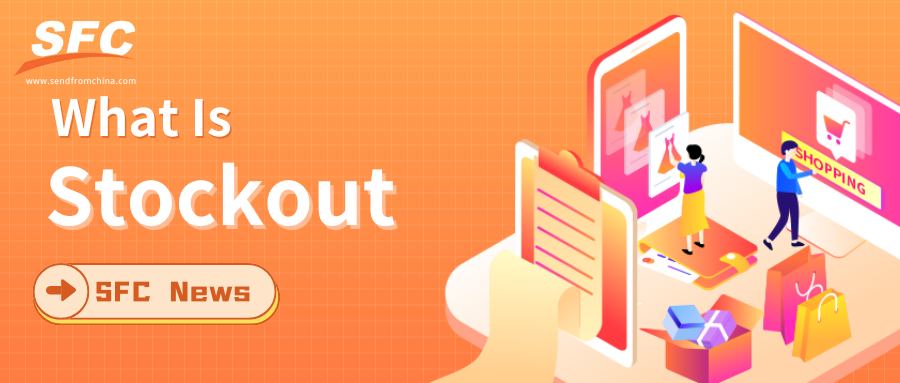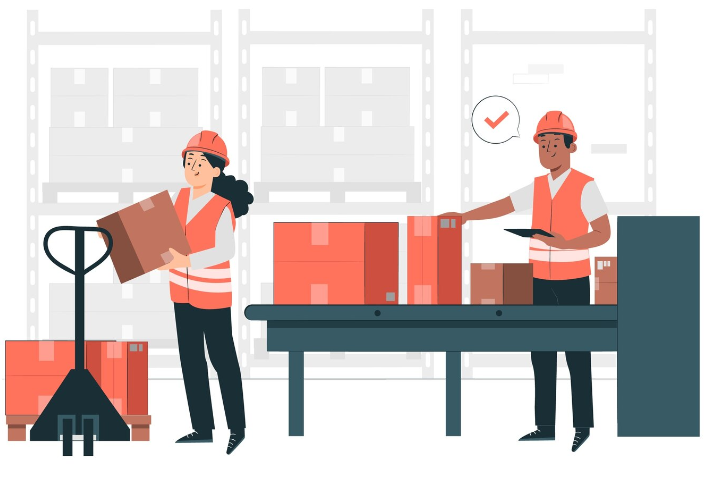Table of Contents
Get Custom eCommerce Fulfillment Service
Book a Meeting
What Is Stockout? Everything You Need to Know
Time: Nov 01,2024 Author: SFC Source: www.sendfromchina.com
Stockouts are a common yet costly challenge for businesses of all sizes. When products are unexpectedly out of stock, companies not only lose sales but also risk damaging customer loyalty and brand reputation. In today’s competitive market, where consumers expect quick, reliable service, even a brief stockout can push customers toward competitors. Understanding stockouts—what they are, why they happen, and how to prevent them—is essential for any business that aims to optimize inventory and maintain customer satisfaction.
In this guide, we’ll explore everything you need to know about stockouts, from their causes and impacts to proven strategies for managing and preventing them, so you can keep your shelves stocked and your customers happy.

1. What Is Stockout? The Definition
A stockout, sometimes called an out-of-stock (OOS) incident, is when a business has depleted its inventory for a product, making it unavailable to customers.
Stockout often impacts customer satisfaction, sales revenue, and brand reputation. It also can arise in physical retail stores, e-commerce platforms, or any business model that requires maintaining inventory to meet customer demands. The key to understanding stockouts is to recognize that they stem from demand exceeding available supply, whether due to poor demand forecasting, supply chain delays, or unforeseen spikes in demand.
2. How Do Stockouts Happen

Stockouts can result from several interwoven factors, often stemming from issues in demand forecasting, supply chain inefficiencies, or inadequate inventory management systems. Below are the primary causes of stockouts:
Inaccurate Demand Forecasting
Forecasting demand with precision is vital. If a business underestimates demand, it risks depleting its stock more quickly than anticipated, resulting in a stockout. Factors such as seasonality, marketing campaigns, and market trends play a critical role in demand forecasting.
Supply Chain Disruptions
Supply chain interruptions due to natural disasters, political unrest, labor strikes, or transportation delays can halt the replenishment of stock. These disruptions, especially in global supply chains, contribute significantly to stockouts.
Inefficient Inventory Management
A lack of sophisticated inventory management systems often leads to stockouts. Outdated methods may overlook low stock signals, fail to reorder in time, or create inaccuracies in inventory level reporting.
Overreliance on Just-In-Time (JIT) Inventory
JIT inventory models, while cost-effective, can lead to stockouts if there is any unexpected delay in the supply chain. Since products are ordered and replenished only as needed, businesses face significant risk if sudden demand surges or logistical delays occur.
3. Effects of Stockouts on Businesses

Stockouts don’t just mean an item is unavailable; they can have far-reaching effects on various aspects of a business, impacting financial performance, customer loyalty, and competitive standing. Here’s how stockouts affect businesses:
Loss of Revenue and Profitability
When a product is out of stock, potential sales are lost, directly impacting revenue. Prolonged stockouts can also harm profitability, especially if customers turn to competitors for alternative options.
Reduced Customer Satisfaction and Loyalty
Customer expectations are high, particularly with online and instant purchasing options. Frequent stockouts can frustrate customers, who may decide not to return to a business that doesn’t consistently meet their needs.
Damage to Brand Reputation
Stockouts reflect poorly on a company’s brand. Consistently failing to have items available can damage a business's reputation as unreliable, pushing potential customers to more dependable alternatives.
Higher Operational Costs
In response to stockouts, businesses often rush orders or expedite shipping to replenish inventory quickly, leading to additional costs. These costs, often called "expediting costs," reduce profitability and strain operational budgets.
4. How to Avoid Stockouts: Effective Strategies

Preventing stockouts is a complex but essential aspect of inventory management. Businesses can adopt several proactive measures to minimize stockouts and ensure products are consistently available to meet customer demands.
Strategy 1: Implement Demand Forecasting Models
Using advanced demand forecasting models that incorporate data analytics, historical sales data, and market trends is essential. Forecasting tools driven by AI and machine learning can significantly enhance accuracy, reducing the likelihood of stockouts.
Strategy 2: Invest in Inventory Management Software
Inventory management systems track stock levels, alert staff to low inventory, and even automate reordering processes. This approach is particularly effective for e-commerce and larger businesses with high SKU counts.
Strategy 3: Adopt a Safety Stock Strategy
Maintaining a buffer stock of high-demand items helps offset unexpected surges in demand or supply chain delays. Safety stock can mitigate the risks of running out during peak seasons or promotional campaigns.
Strategy 4: Diversify Suppliers
Working with multiple suppliers reduces reliance on a single source and minimizes risk in the event of delays or supply issues. Diversified suppliers offer flexibility and resilience, especially for crucial or high-demand items.
Strategy 5: Use Reorder Point Formulas
Determining reorder points for each SKU based on sales data and lead times can help businesses restock effectively. A well-calculated reorder point prevents stockouts by ensuring new stock arrives before inventory levels deplete.
5. How to Deal with Stockouts

Despite best efforts, stockouts may occasionally occur. When they do, businesses can implement strategies to minimize their impact on customers and revenue.
Communicate with Customers Transparently
Transparency is key. Notify customers of stockouts on the website, provide estimated restock dates, and suggest alternative products when possible. This openness can help retain customer trust and loyalty.
Offer Backordering Options
Allowing customers to place orders for out-of-stock items with a future fulfillment date can help retain sales and provide assurance to customers. Backordering is a particularly effective solution for high-demand or exclusive products.
Monitor Stock Levels Closely During High-Demand Periods
Using demand analytics to closely monitor stock levels during peak times like holidays, sales events, or new product launches allows businesses to react quickly to demand changes and prevent further stockouts.
Prioritize High-Margin Products
In the event of inventory shortages, prioritizing high-margin products for restocking can optimize profitability while maintaining essential customer satisfaction.
6. Common Stockouts Costs

Stockouts carry several hidden and overt costs that impact a business's financial stability. Beyond the immediate revenue loss, businesses face additional expenses when they experience stockouts.
Lost Sales Revenue
When a product is unavailable, each missed sale is a direct revenue loss. Over time, these lost sales can accumulate, impacting the bottom line.
Expediting and Emergency Shipping Costs
To address stockouts quickly, businesses may expedite shipments or source products from more expensive suppliers, increasing logistics costs.
Marketing and Customer Recovery Costs
Once a customer is lost to a competitor due to a stockout, it can take costly marketing efforts to reacquire them. Promotional discounts or loyalty programs may also be needed to regain trust.
Penalty Fees from Retail Partners
Retailers or partners may impose penalty fees if stockouts result in delayed or canceled orders, especially in the case of exclusive distribution agreements.
7. How to Calculate Stockout Probability

Calculating stockout probability allows businesses to anticipate the likelihood of running out of stock, helping inform safety stock levels and reorder points. The formula to calculate stockout probability often incorporates average demand, lead time, and standard deviation in demand.
Use Historical Sales Data
Analyzing historical data on demand fluctuations helps determine standard deviation and provides a foundation for calculating stockout risk.
Implement Stockout Probability Formula
The stockout probability formula is typically structured as follows:Stockout Probability=(Lead Time Demand−Current Inventory Level)/Standard Deviation of Demand
8. FAQs
1. How can stockouts be predicted?
Stockouts can be predicted using demand forecasting tools, historical sales data analysis, and monitoring of lead times and supplier reliability.2. What are the most effective ways to prevent stockouts?
Effective stockout prevention includes maintaining safety stock, using inventory management software, implementing reorder points, and diversifying suppliers.3. How does a stockout affect customer satisfaction?
Stockouts often lead to customer dissatisfaction, as customers may feel frustrated by unavailability. This can reduce customer loyalty and push them toward competitors.4. Why are stockouts common in e-commerce?
Stockouts in e-commerce are often due to rapid demand fluctuations, inaccurate forecasting, supply chain disruptions, or reliance on just-in-time inventory.5. Can stockouts ever benefit a business?
While rare, temporary stockouts for exclusive or high-demand items can create urgency or anticipation, sometimes leading to increased demand once the product is back in stock. Post Views:3161
Post Views:3161
Copyright statement: The copyright of this article belongs to the original author. Please indicate the source for reprinting.
Previous Post
USPS Flat Rate Box & Envelope Sizes and Prices
Next Post
TAGS
Hot Research
Get Custom eCommerce Fulfillment Service
Book a Meeting
Get a Custom China Fulfillment Solution with FREE Storage for 30 Days
 Want to know about our services, fees or receive a custom quote?
Want to know about our services, fees or receive a custom quote?
 Please fill out the form on the right and we will get back to you within a business day.
Please fill out the form on the right and we will get back to you within a business day.
 The more information you provide, the better our initial response
will be.
The more information you provide, the better our initial response
will be.





 TAGS:
TAGS: